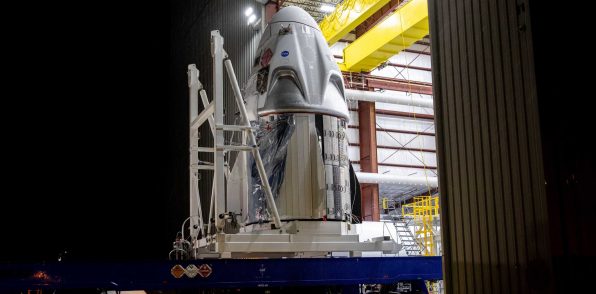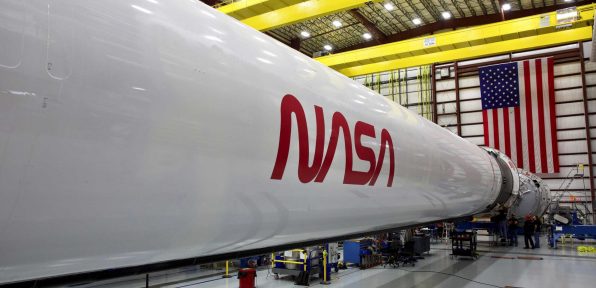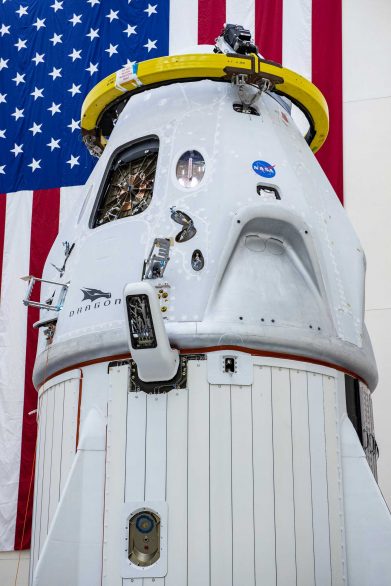10.05.2020
Dragon astronauts wrap up training, prepare to enter quarantine
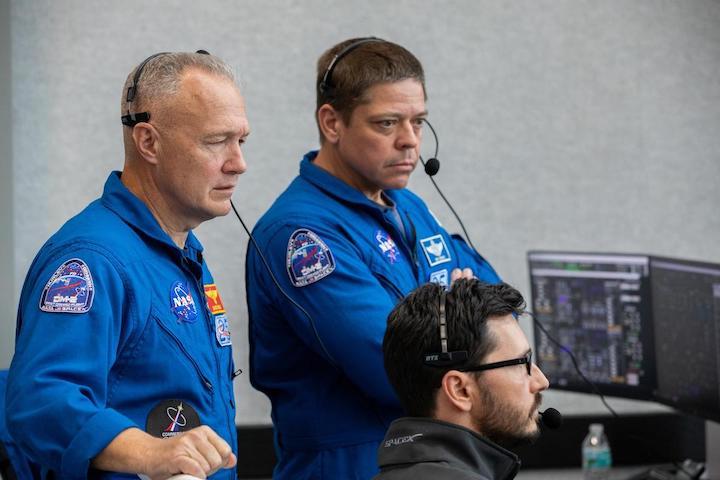
NASA astronauts Bob Behnken and Doug Hurley completed their final training sessions in Houston this week before their scheduled May 27 liftoff on a SpaceX Dragon spacecraft from the Kennedy Space Center, the first launch of humans from the Florida spaceport since 2011.
The two veteran space fliers participated in their final full-up launch simulation Monday, strapping into a Dragon simulator at the Johnson Space Center in Houston and tying in with SpaceX and NASA teams at the Kennedy Space Center in Florida and at SpaceX headquarters in Hawthorne, California.
Behnken tweeted Thursday that the crew’s formal training activities were complete. The astronauts were expected to have a few days of off-duty time before preparing to travel from their home base in Houston to the Kennedy Space Center on May 20.
Brandi Dean, a spokesperson at NASA’s Johnson Space Center in Houston, said Behnken and Hurley will begin their formal pre-launch quarantine protocol May 13. The astronauts are expected to spend several days inside a quarantine facility at Johnson, then fly aboard NASA aircraft to Kennedy on May 20 to begin final launch preparations.
The pre-launch quarantine protocol is a regular part of all human spaceflight missions, but Behnken and Hurley have effectively been quarantined for weeks, once physical distancing measures were introduced to combat the spread of the COVID-19 viral disease.
In quarantine, the astronauts will only be in close proximity to close family members and SpaceX and NASA personnel who receive medical screening.
“We’re already in quarantine with our families, and we plan to continue that,” Behnken said May 1. “NASA has a plan to get our families to Kennedy in a quarantined fashion, and then to allow us to continue to see each other.”
NASA and SpaceX are continuing with preparations for Behnken and Hurley’s launch on the Crew Dragon spacecraft amid the coronavirus pandemic. NASA is limiting the number of guests permitted at the space center, and the Kennedy Space Center Visitor Complex is not selling tickets for public viewing on NASA property.
The visitor complex temporarily closed in mid-March and has not announced a schedule to reopen.
“What will be different is the causeway and the number of guests who will be able to watch form a distance, normally in large groups kind of looking across the water and seeing the launch happen,” Behnken said. “We’re not expecting that to be possible based on the COVID-19 situation.
“So folks will be hopefully watching at home on their computers, or on television, when we launch into space rather than seeing it with their own eyes, which is a little bit of a disappointment,” said Behnken, an Air Force colonel and veteran of two space shuttle missions. “But with the situation, I think it’s the right thing for folks to stay protected.”
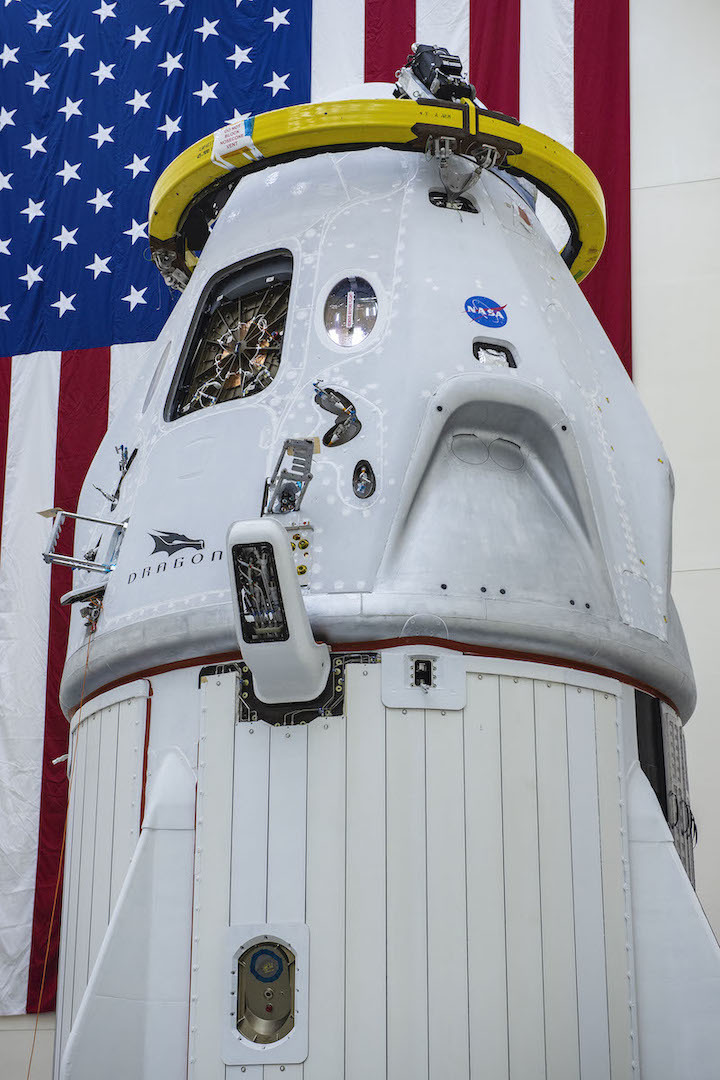
Behnken will serve as the joint operations commander for the Crew Dragon flight, designated Demo-2, or DM-2. The 49-year-old Missouri native will be responsible for the mission’s rendezvous and docking with the International Space Station, along with activities once aboard the orbiting research lab.
Hurley, a Marine Corps colonel who hails from Upstate New York, will be the spacecraft commander on the Demo-2 test flight. His responsibilities include launch, landing and recovery operations.
Behnken and Hurley were two of four NASA astronauts selected in 2015 to train for commercial crew missions on SpaceX and Boeing capsules. NASA assigned the two-man crew to the SpaceX Demo-2 mission in 2018.
NASA has signed a series of funding agreements with SpaceX since 2011 valued at more than $3.1 billion. With NASA funding and technical oversight, SpaceX has developed the human-rated Crew Dragon spacecraft to launch on the company’s Falcon 9 rocket.
Boeing has received a similar series of contracts from NASA to develop the Starliner crew capsule.
SpaceX completed a six-day unpiloted Crew Dragon test flight, known as Demo-1, to the space station in March 2019. The Crew Dragon has also completed two launch abort tests, one demonstrating the ship’s ability to escape an emergency on the launch pad, and another to prove the capsule can safely fire off the top of a Falcon 9 rocket in flight.
Behnken and Hurley are expected to spend one to four months on the space station. Since their assignment to the Dragon test flight, the astronauts have completed thousands of hours of training, much of it inside simulators at SpaceX headquarters in Southern California.
“A lot of times we focus on Crew Dragon, which, of course, is kind of the crown jewel and what carries the astronauts,” said Benji Reed, SpaceX’s director of crew mission management. “But there’s really a whole system that runs from the engineers and design and analysis that goes on, to the factory fabrication and all the testing, and it is all involved in the Falcon 9 launch vehicle, the Dragon spacecraft, the operational teams and all the operational centers.”
The Demo-2 astronauts also completed refresher training on space station systems in Houston. Behnken was certified to perform spacewalks from the space station’s airlock, and Hurley is trained to operate the station’s Canadian-built robotic arm.
The Demo-2 crew was originally training for a stay of just one or two weeks, but NASA extended the duration of the Demo-2 test flight after development delays in the commercial crew program left the space station with just one U.S. astronaut on-board.
NASA astronaut Chris Cassidy is commander of the space station’s Expedition 63 currently living and working on the orbiting research lab. Cassidy launched from the Baikonur Cosmodrome in Kazakhstan on a Soyuz spacecraft April 9 with two Russian crewmates.
Since the retirement of the space shuttle in 2011, Russian Soyuz spacecraft have been the only way for U.S. astronauts to fly to and from the space station. NASA has paid Roscosmos — Russia’s space agency — approximately $3.9 billion for Soyuz seats since 2006.
NASA officials intend to end the cash payments to Russia once declaring the Crew Dragon and Starliner spacecraft operational. Final certification of the Crew Dragon is expected after Behnken and Hurley return to Earth later this year, allowing future Crew Dragons to carry up to four astronauts at a time on regular crew rotation flights to the space station.
Space station managers eventually plan to fly a Russian cosmonaut on U.S. crew missions and a NASA astronaut on Russian Soyuz flights, ensuring at least one representative of each nation is aboard the station at all times.
But Russian officials said they will not approve the plan for mixed crews on U.S. crew capsules until the Crew Dragon and Starliner complete their first piloted space missions.
The first operational Crew Dragon mission is scheduled to launch after the Demo-2 astronauts return to Earth. Three NASA astronauts and a Japanese crew member are assigned to that flight to the space station.
But the schedule for that mission hinges on a successful Demo-2 test flight.
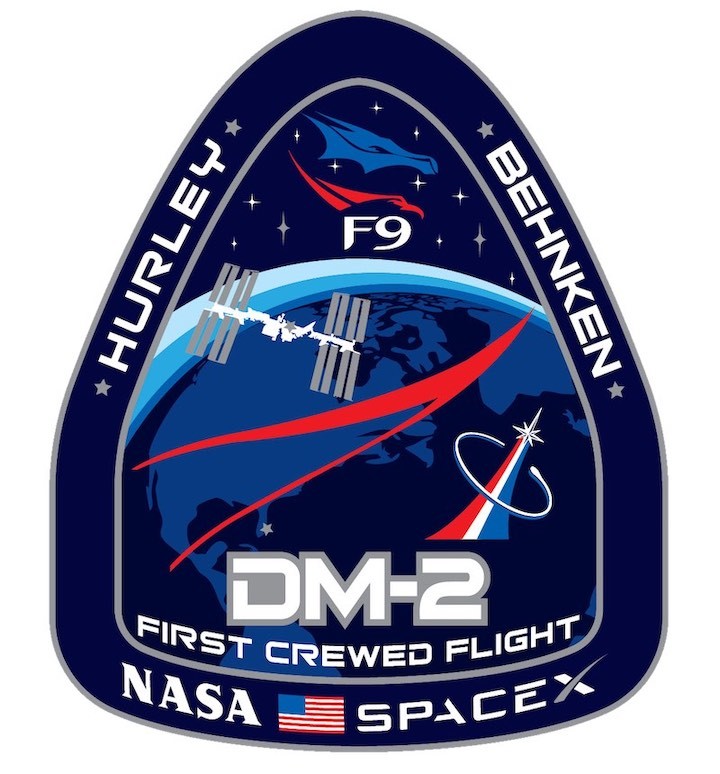
Once at the Kennedy Space Center, Behnken and Hurley will participate in final briefings, spacesuit checkouts, and a full launch day dress rehearsal scheduled for May 23. During the launch day dry run, the astronauts will put on their SpaceX-made flight suits, walk out of the Operations and Checkout Building at Kennedy, and travel to launch pad 39A inside a Tesla Model X.
The crew members will board the Crew Dragon and strap into their seats, running through many of the pre-launch procedures they will execute on the real launch day.
On May 22, the day before the scheduled dress rehearsal, SpaceX plans to fill the Falcon 9 rocket with super-chilled kerosene and liquid oxygen propellants and ignite the first stage’s nine Merlin engines on pad 39A. The engines will fire for several seconds in the static fire test, which is a customary part of all SpaceX launch campaigns.
SpaceX will drain the rocket’s propellant tanks before the crew dress rehearsal on the following day.
NASA and SpaceX officials also plan to convene a flight readiness review around May 21 to give approval to proceed with final mission preparations. Another meeting of top managers is planned May 25 in a launch readiness review.
Liftoff of the 215-foot-tall (65-meter) Falcon 9 rocket with Behnken and Hurley is set for May 27 at 4:33 p.m. EDT (2033 GMT) to begin a nearly nine-minute climb into orbit.
Assuming an on-time launch, the Crew Dragon spacecraft is scheduled to dock with the space station around 11:30 a.m. EDT (1530 GMT) on May 28.
Quelle: SN
----
Update: 17.05.2020
.
Dragon crew begins augmented version of NASA’s standard pre-launch quarantine
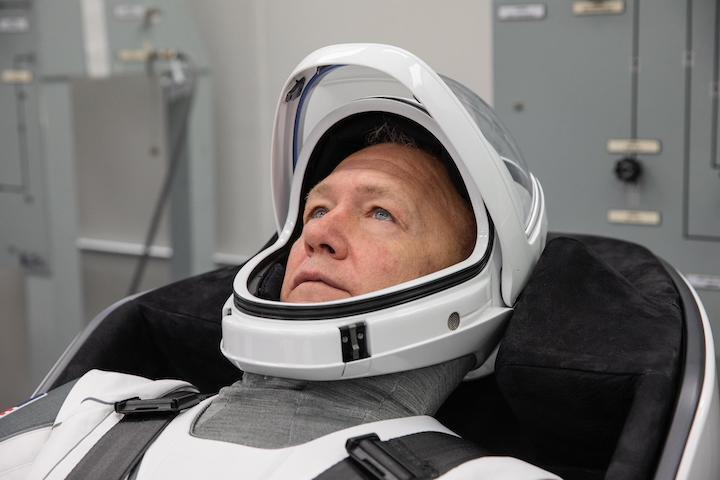
NASA has added extra safeguards to the agency’s standard pre-launch quarantine protocol to protect astronauts Bob Behnken and Doug Hurley from the coronavirus and other contagions in the final two weeks before their scheduled May 27 launch on SpaceX’s Crew Dragon spacecraft.
The two-man crew will quarantine at their homes near the Johnson Space Center in Houston until next Wednesday, May 20, when they fly aboard a NASA Gulfstream jet to the Kennedy Space Center in Florida to begin the final week of preparations for liftoff, according to Brandi Dean, a NASA spokesperson.
Known as “flight crew health stabilization,” NASA’s astronaut quarantine procedures are a routine step before crewed space missions. NASA introduced the quarantine in the Apollo program, when astronauts traveled to the moon, and the health stabilization timeline has been a standard part of crew preparations before space shuttle and International Space Station missions.
But this mission’s pre-launch quarantine comes with some changes amid the coronavirus pandemic.
Behnken and Hurley officially entered quarantine Wednesday, May 13, two weeks before their scheduled launch. The two-man crew will take off inside a SpaceX Crew Dragon spacecraft launched on top of a Falcon 9 rocket from pad 39A at the Florida spaceport.
Designated Demo-2, the test flight is intended to be a shakedown cruise for the Dragon spacecraft before future crews fly on the capsule for operational missions.
The launch later the month will be the first flight from U.S. soil to carry into orbit since the last shuttle mission in July 2011. Assuming an on-time launch May 27, the Dragon capsule is slated to dock with the International Space Station the next day, kicking off a stay of one-to-four months at the orbiting research lab.
The Dragon crew will join space station commander Chris Cassidy and Russian cosmonauts Anatoly Ivanishin and Ivan Vagner, expanding the station’s crew complement from three to five.
“Spending the final two weeks before liftoff in quarantine helps ensure the Demo-2 crew arrives healthy, protecting themselves and their colleagues already on the station,” NASA said.
NASA will limit who can be in close contact with Behnken and Hurley up until their launch.
“Since Hurley and Behnken are training side by side and will be working and living as a team on the space station with their crewmates, they’re unable to maintain a six-foot distance,” NASA said.

Some astronauts choose to stay in a quarantine facility at the Johnson Space Center in Houston before traveling to Florida for final launch preparations. Crew members may have to stay at the NASA facility if a family member living with them at home can’t quarantine due to job or school requirements, according to the space agency.
Behnken and Hurley are staying at their homes until their trip next week to the launch site on Florida’s Space Coast.
“Some additional safeguards have been added because of the coronavirus,” NASA said. “For example, anyone who will come on site or interact with the crew during the quarantine period, as well as any VIPs, will be screened for temperature and symptoms.”
NASA said Hurley and Behnken, as well as those in direct, close contact with the crew, will be tested twice for the virus before their May 27 launch as a precaution.
“The coronavirus, obviously, has presented us with some new challenges,” said Phil McAlister, NASA’s director of commercial spaceflight development. “If we didn’t have enough, we’ve got that on the plate. I just want to stress we are following a strict, 14-day quarantine protocol prior to launch for the crew members. All personnel that support or interact with the crew during that time period follow that same protocol.”
McAlister told a committee of the NASA Advisory Council on Thursday that anyone not following the quarantine protocols will not be permitted to interact with the Demo-2 crew members “without appropriate protective gear, appropriate distancing or a barrier between them and the astronaut.”
“I think we’re being pretty careful with all that,” McAlister said. “SpaceX has been really good in implementing some additional protective measures.”
SpaceX Crew Dragon joins Falcon 9 for last mate before astronaut launch debut
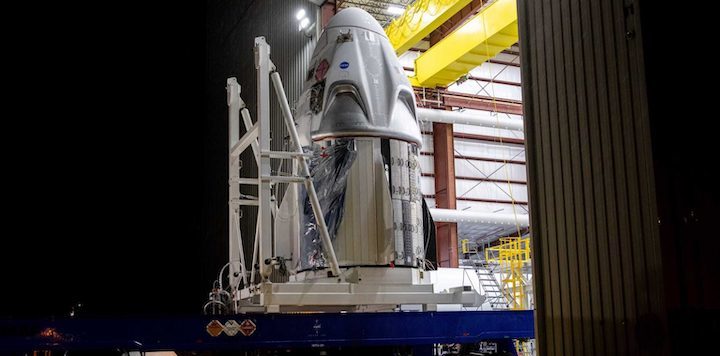
NASA and SpaceX are less than two weeks away from the first crewed mission to launch from U.S. soil in nearly a decade. But there’s still work to do before the craft blasts off towards the International Space Station.
On Friday, May 15, the Crew Dragon spacecraft journeyed from a fueling facility at Cape Canaveral’s Air Force Station to launch pad 39A at NASA’s Kennedy Space Center. Tucked inside the SpaceX hangar, the craft will undergo testing and checkouts before being attached to it Falcon 9 launcher in a few days.
The Dragon was filled up with hypergolic fuel (hydrazine and nitrogen tetroxide), which its built-in escape system and onboard thrusters use to maneuver.
Liftoff is scheduled for May 27 at 4:33 p.m. EDT (2033 UTC). At that time, NASA astronauts Bob Behnken and Doug Hurley will rocket towards space, and synch up with the space station less than 24 hours later. During their time on orbit, the duo will put the Crew Dragon’s systems to the test.
Hurley will get to manually pilot the autonomous spacecraft, ensuring the control systems are working as expected. Then the spacecraft will begin the docking process. But before Dragon can attach itself to the space station, it has to be prepped for launch.
This week, SpaceX crews will inspect the Dragon’s electrical and mechanical attachments before attaching it to the Falcon 9. Using a massive crane, the crew will hoist the Dragon onto the rocket. The duo will then be loaded onto SpaceX’s transporter and make the trek up to the launch pad.
Hurley and Behnken know this pad well. Both astronauts flew their previous missions after launching from this pad. The crew is set to make the trip to Kennedy this week, arriving on May 20. They’ve been in official mission quarantine since May 13, although the duo has quarantined with each other for several weeks now, with minimal contact with other non-essential staff members.
Once the Dragon and Falcon are on the launch pad, SpaceX engineers will take some time to inspect and examine the vehicles before putting the Falcon through some routine pre-launch testing, including a fueling run and a static fire test.
The next major hurdle before launch will be a flight readiness review, which will take place on May 21. If that goes as planned, there will be a final launch readiness review on May 25th. In the meantime, after they arrive at the launch site, Behnken and Hurley will undergo some last-minutes training, make sure their spacesuits are fitting correctly, and do a full launch practice run on Saturday, May 23.
According to NASA, there is still a lot of work to be done ahead of the May 27th launch date, but currently, everything is on schedule. Once on station, Behnken and Hurley will stay up to four months on the orbital outpost before returning to Earth.
Quelle: TESLARATI
----
Update: 22.05.2020
.
Dragon crew arrives at Florida spaceport kick off final week of launch preps
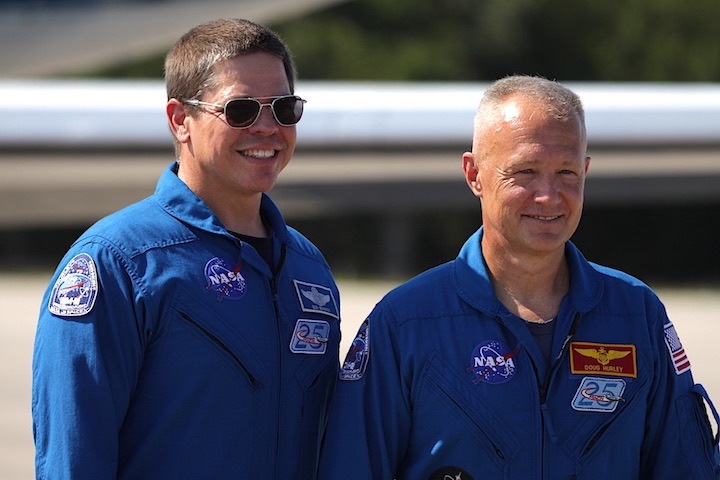
Astronauts Doug Hurley and Bob Behnken arrived Wednesday at the Kennedy Space Center, ready for spacesuit and spacecraft fit checks, and some time off with their families before launching next week on the first crewed flight into orbit from U.S. soil since 2011.
Hurley and Behnken, each veterans of two space shuttle flights, rode a NASA Gulfstream business jet from their home base in Houston to Florida spaceport, where they were greeted by NASA managers and a limited number of reporters and photographers, all wearing masks and observing physical distancing guidelines due to the coronavirus pandemic.
“Both Doug and I are really excited to be here,” Behnken said. “This is an awesome time to be an astronaut with a new spacecraft to get a chance to go and fly.”
The astronauts are scheduled to launch next Wednesday, May 27, from pad 39A at Kennedy aboard a SpaceX Falcon 9 rocket and Crew Dragon spacecraft. Liftoff is set for 4:33:33 p.m. EDT (2033:33 GMT), a time set to allow the Dragon capsule to launch into the same orbital plane of the International Space Station.
Assuming an on-time launch next Wednesday, Hurley and Behnken are slated to dock with the orbiting research laboratory around 11:39 a.m. EDT (1539 GMT) on May 28.
NASA Administrator Jim Bridenstine and Bob Cabana, director of the Kennedy Space Center, welcomed the Dragon crew to Florida’s Space Coast.
“I know times are tough right now,” Bridenstine said. “Bob Cabana and I have been walking around in our masks. Everybody wants to shake hands, and yet we have to resist. We just welcomed our astronauts and we couldn’t shake (their hands). We were waving from six feet away, and we’re looking at all the media that are here, and everybody is wearing their masks. This is a tough time in American history. It’s a tough time in world history.
“But it is not unique,” Bridenstine continued, referring to the unrest of the 1960s.
“We had a war raging in Vietnam, we had protests,” he said. “We had civil rights abuses, and civil rights protests. We had division in this country the likes of which we’ve never seen before, and at the same time NASA was able to unite not just the United States of America, but we were able to unite the world in that very unique moment, where we saw Neil Armstrong and Buzz Aldrin land on the moon.
“Now here we are at this point where NASA has not had access to the International Space Station with its own rockets now for nine years, and this is a moment when we can all look and be inspired as to what the future holds.”
Behnken will serve as the joint operations commander for the Crew Dragon flight, designated Demo-2, or DM-2. The 49-year-old Missouri native will be responsible for the mission’s rendezvous and docking with the International Space Station, along with activities once aboard the orbiting research lab.
Hurley, a retired Marine Corps colonel who hails from Upstate New York, will be the spacecraft commander on the Demo-2 test flight. His responsibilities include launch, landing and recovery operations.
Behnken and Hurley were two of four NASA astronauts selected in 2015 to train for commercial crew missions on SpaceX and Boeing capsules. NASA assigned the two-man crew to the SpaceX Demo-2 mission in 2018.
NASA has signed a series of funding agreements with SpaceX since 2011 valued at more than $3.1 billion. With NASA funding and technical oversight, SpaceX has developed the human-rated Crew Dragon spacecraft to launch on the company’s Falcon 9 rocket.
Boeing has received a similar series of contracts from NASA — valued at more than $4.8 billion — to develop the Starliner crew capsule.
But those figures include NASA payments to the contractors to cover crew transportation services, once the Crew Dragon and Starliner vehicles are operational. Phil McAlister, NASA’s head of commercial spaceflight development, said May 13 that the space agency invested around $5 billion toward Crew Dragon and Starliner design and development.
The companies also put in an unspecified level of private funding, a requirement under the public-private partnership arrangement pursued by NASA’s commercial crew program since 2010.

At the time of the space shuttle’s retirement in 2011, NASA hoped to have the commercial crew ships flying astronauts by 2015. But that schedule has slipped, initially due to a lack of funding appropriated by Congress, then by myriad technical delays suffered by SpaceX and Boeing.
“Bob and I have been working on this program for five years, day in and day out, and there are folks here at NASA and at SpaceX, (for whom) it’s been longer than that,” Hurley said. “It’s been a marathon in many ways, and that’s what you would expect to develop a human-rated space vehicle that can go to and from the International Space Station,” Hurley said. “So I think it’s a long time coming in some ways.”
SpaceX completed a six-day unpiloted Crew Dragon test flight, known as Demo-1, to the space station in March 2019. The Crew Dragon has also completed two launch abort tests, one demonstrating the ship’s ability to escape an emergency on the launch pad, and another to prove the capsule can safely fire off the top of a Falcon 9 rocket in flight.
The Starliner program is likely nearly a year from its first piloted spaceflight. Boeing’s first Starliner test flight without astronauts faltered before reaching the International Space Station due to a software error in December, and engineers are wringing out the problems before trying another unpiloted demonstration mission this fall.
Wednesday’s arrival of space-bound astronauts at the Kennedy Space Center was the first such event at the Florida spaceport since July 4, 2011, when the final space shuttle crew jetted to the launch base.
Hurley was the pilot on that mission, giving him the distinction on flying on back-to-back spaceflights taking off from Kennedy.
“When you fly a shuttle flight, by the time you land, you’re just exhausted,” Hurley said Wednesday. “You’re glad that you had a successful mission, and you just want to see your family. I think after that, you think about, ‘OK, what’s next?'”
NASA astronauts continued soaring into space on Russian Soyuz spaceships, logging record-long expeditions on the International Space Station. But Hurley said didn’t know if he would ever fly in space again.
“It’s an evolving thing, and the folks at NASA had a great idea to form a public-private partnership with companies and compete for … and it has ended up in this situation,” Hurley said. “And we’re lucky enough to be on the vehicle. It has been a long road in a lot of ways, but I certainly consider myself lucky to be part of it.”
Behnken and Hurley are expected to spend one to four months on the space station. Since their assignment to the Dragon test flight, the astronauts have completed thousands of hours of training, much of it inside simulators at SpaceX headquarters in Southern California.
After the final full-up launch simulation May 4, the Demo-2 crew wrapped up their official training sessions and entered NASA’s quarantine protocol May 13. Hurley said they completed their final pre-launch “proficiency” session Tuesday in a Dragon simulator at the Johnson Space Center in Houston.

SpaceX teams at Kennedy plan to roll out the Falcon 9 rocket and Crew Dragon spacecraft to pad 39A ahead of a static test-firing of the launch vehicle’s Merlin main engines Friday.
Behnken said he’s looking forward to spending some time with his family at the famed Astronaut Beach House — officially named the Kennedy Space Center Conference Center — where numerous crews have passed time before their space missions
“They’ve been observing a pretty tight quarantine to make that a possibility,” Behnken said of the crew’s families.
On Saturday, Hurley and Behnken will put on their SpaceX-made spacesuits and travel to pad 39A inside a Tesla Model X, an example of cross-branding between two companies founded by billionaire Elon Musk. The astronauts will board the Dragon capsule at pad 39A and run through pre-launch procedures up to the point where the rocket would be fueled during a real countdown.
“We’ll get a chance to put our spacesuits on again to make sure that they’re finally completely up and ready for the actual event,” Behnken said. “We’ll get a chance to climb into the Dragon capsule, strap in and walk through the pre-launch timeline inside the vehicle.
“That’ll involve riding in the Teslas out to the launch pad, going through that whole exercise just to polish the team one more time prior to the launch. Then, of course, the big show in the 27th.”
Quelle: SN
----
Update: 23.05.2020
.
Astronauts Arrive in Florida for Launch Next Week with SpaceX on Demo-2 Mission
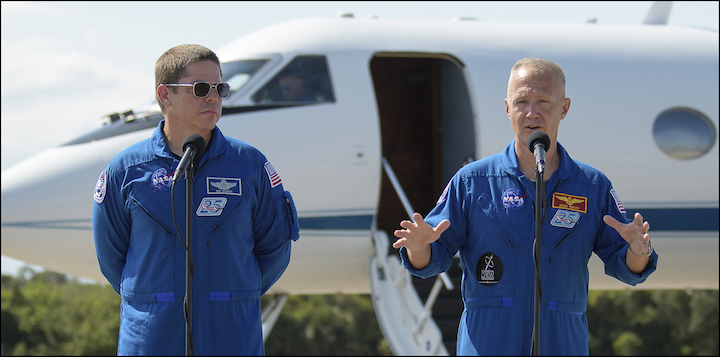
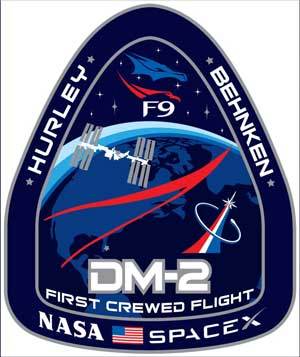
One week from today, at 4:33 p.m. EDT on Wednesday, 27 May, the man who piloted the final Space Shuttle mission and a former chief of NASA’s astronaut corps will buckle aboard a Crew Dragon and launch atop a Falcon 9 booster from historic Pad 39A at the Kennedy Space Center (KSC) in Florida. In so doing, seasoned shuttle pilot Doug Hurley and veteran spacewalker Bob Behnken will become the first U.S. astronauts to launch aboard a U.S. spacecraft, atop a U.S. rocket, and from U.S. soil, since the end of the shuttle era in July 2011.
The duo will dock with the International Space Station (ISS) early Thursday, 28 May, about 19 hours after launch, and will join the Expedition 63 crew of Commander Chris Cassidy of NASA and Russian cosmonauts Anatoli Ivanishin and Ivan Vagner, forming a five-man increment. According to NASA, Hurley and Behnken will remain aboard the station for at least a month and perhaps as long as 119 days, the projected lifespan of the solar-cells on their Crew Dragon spacecraft.
Quelle: AS
+++
NASA and SpaceX are 'go' to proceed with historic launch of astronauts
Teams at Kennedy Space Center on Friday completed a critical readiness review for the upcoming launch of two astronauts, giving NASA and SpaceX the "go" to proceed with preparations for liftoff.
"We have another milestone under our belts," NASA Administrator Jim Bridenstine told reporters of the mission slated to launch at 4:33 p.m. Wednesday. "Everyone in the room was very clear that now was the time to speak up if there were any challenges."
"After each system and subsystem was considered," he said, "we got to a 'go.'"
Wrapping up the flight readiness review, or FRR, sets the stage for astronauts Bob Behnken and Doug Hurley to continue Crew Dragon preparations, which will run through the Memorial Day weekend. The veteran astronauts are expected to arrive at the International Space Station at 11:39 a.m. Thursday, where they'll spend the next one to four months.
A human-rated vehicle with astronauts on board hasn't launched from the Space Coast since the space shuttle's final flight in July 2011.
"Wow. A really big day for the joint NASA-SpaceX Commercial Crew team," said Kathy Lueders, NASA's Commercial Crew Program manager. "But we're not done. We've got do this right. We've got to launch Bob and Doug, we've got to make sure they're taken care of on orbit, and we've got to make sure they get home."
An all-clear FRR also meant SpaceX could proceed with test firing Falcon 9's Merlin main engines, which appeared to go smoothly at 4:33 p.m. – exactly five days before liftoff.
The FRR included input from NASA, SpaceX, the Air Force and Space Force, and the space agencies of Russia and Japan, both of which are partners on the ISS. Russia's Roscosmos, for example, had been concerned that Crew Dragon could strike the station and cause catastrophic damage, but that issue had been resolved by SpaceX after the capsule's flight in March 2019.
Teams also discussed other issues like parachute performance, the April 2019 anomaly that destroyed a Crew Dragon capsule at Cape Canaveral Air Force Station, and a "performance shortfall" of the fire suppression system. After discussions and analysis, all were cleared.
Behnken and Hurley, meanwhile, are under strict coronavirus quarantine limitations at KSC's Operations and Checkout Building. This weekend, they'll don their SpaceX suits, ride out to the pad in NASA-branded Tesla SUVs, and rehearse the historic mission that lies ahead.
Their families are also expected to arrive soon, giving the astronauts time to enjoy their company at the famous "Astronaut Beach House."
Over the weekend, the Space Force is expected to issue its first weather forecast for the mission known as Demonstration 2. But this flight is more prone to weather limitations than other Falcon 9 missions, according to Benji Reed, SpaceX's director of crew mission management.
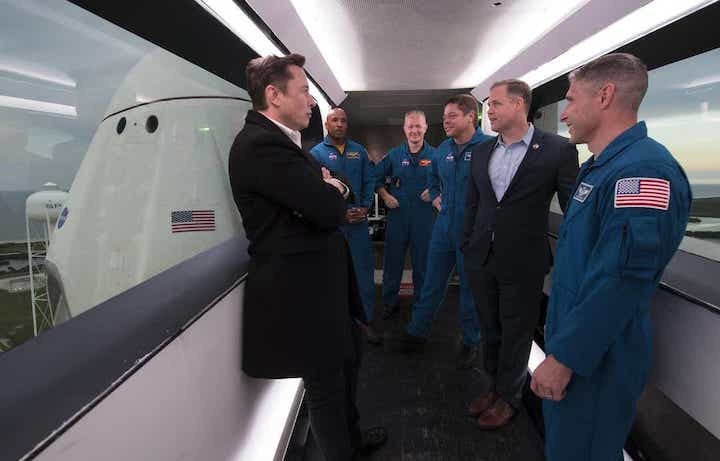
With the ability for Crew Dragon to abort the mission with its powerful SuperDraco engines, Reed said SpaceX also has to consider weather conditions long after liftoff. A storm in the Atlantic Ocean, for example, would pose a threat if Behnken and Hurley had to abort and splash down in tumultuous waters.
"There are over 50 points where we're monitoring weather all the way along the ascent track," Reed said. "Which means from here in Florida all the way up the eastern seaboard of North America and all the way over basically to Ireland."
After the forecasts are issued, NASA and SpaceX will conduct another review on Monday known as the launch readiness review, or LRR. If that goes smoothly, teams will have the final stamp of approval to proceed with Wednesday's launch.
Quelle: Florida Today
----
Update: 24.05.2020
.
SpaceX, Falcon 9 for Demo-2 mission conducts critical static fire test
SpaceX’s Falcon 9 rocket has conducted a static fire test ahead of the Crew Dragon Demo-2 mission. The static fire was part of the ongoing series of final tests and reviews before SpaceX embarks on its first human spaceflight mission. The test took place at 16:33 EDT (20:33 UTC).
The test was the final time NASA has to gather data on SpaceX’s load-and-go fueling process as Demo-2 will be the first time NASA allows a rocket to be fueled for flight with a crew onboard.
Demo-2’s launch is currently set for May 27th at 16:33:31 EDT (20:33:31 UTC). If a problem comes up that necessitates a scrub – such as poor weather or a vehicle issue – the next available date would be May 30th.
The flight will mark the first crewed orbital mission from the United States since July 2011, when the Space Shuttle was retired. The Falcon 9 and Crew Dragon will carry NASA astronauts Bob Behnken and Doug Hurley to the International Space Station (ISS) for one to four months depending on Dragon’s on-orbit performance.
But before that can happen, one of the last major milestones before flight is has to take place: the static fire.
The test consists of a complete rehearsal of most launch day activities. SpaceX has performed at least one static fire before every mission to date – all the way back to the Falcon 1.
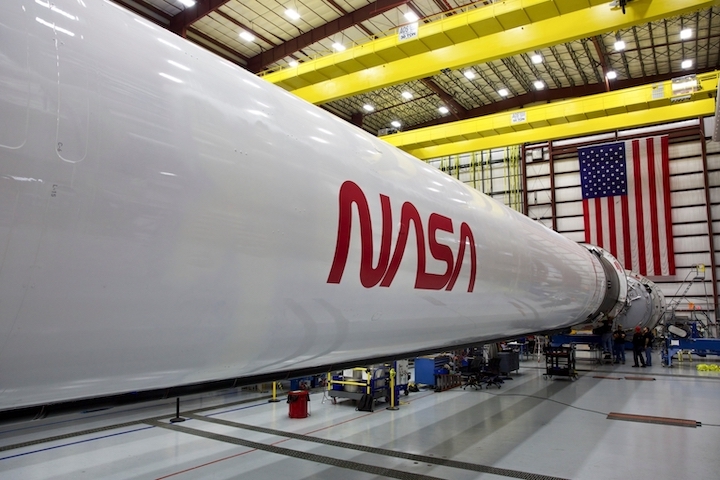
A day prior to the test, teams rolled the completed Falcon 9 stack out of the Horizontal Integration Facility (HIF) to launch pad LC-39A and raised it vertical. This specific rocket contains first stage core B1058 on what will be its first flight.

